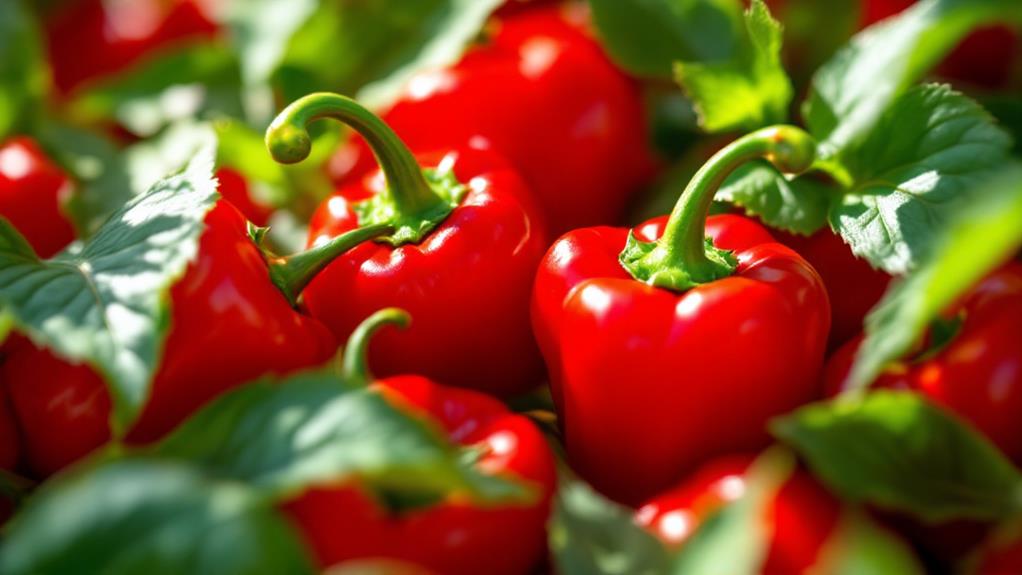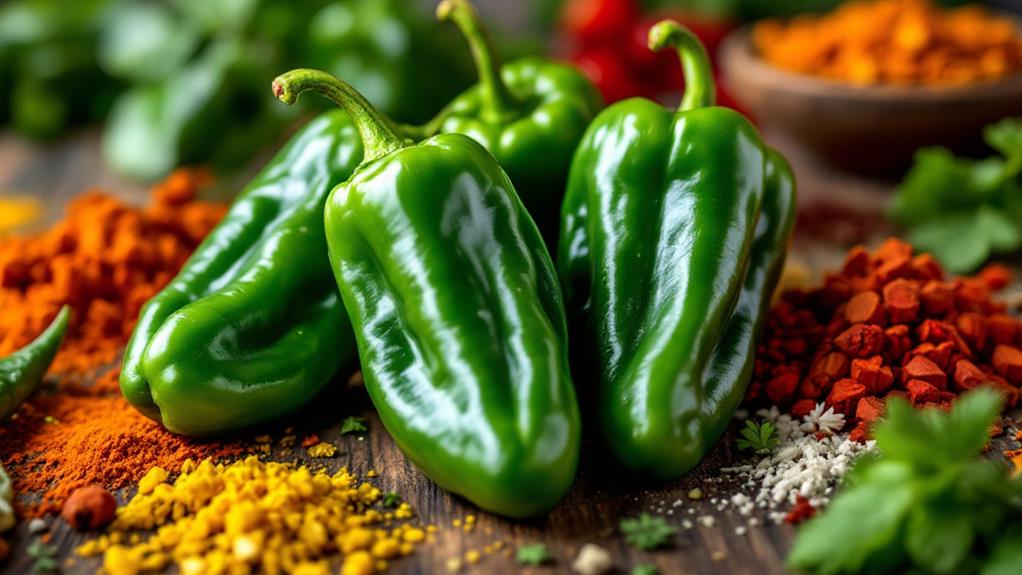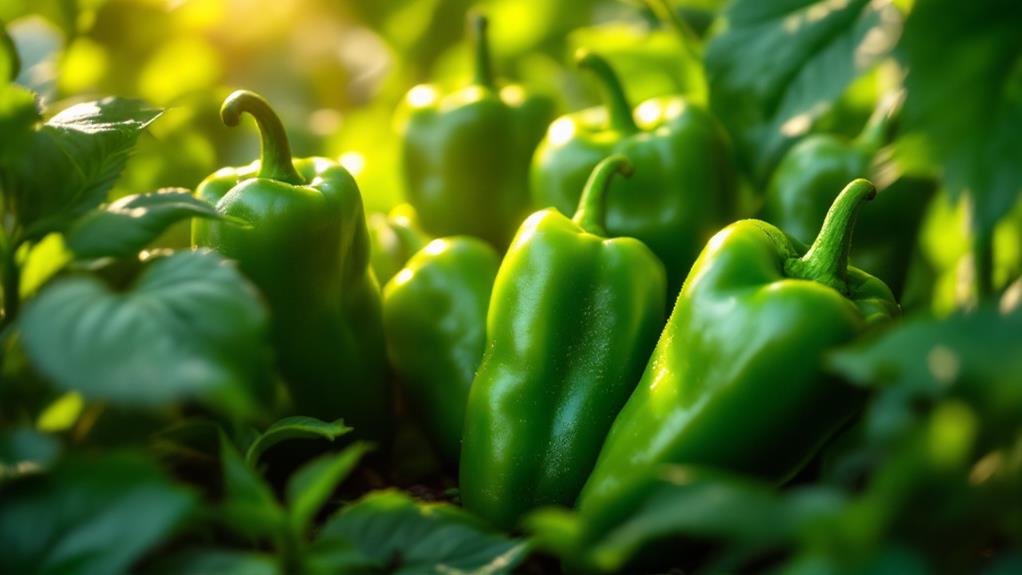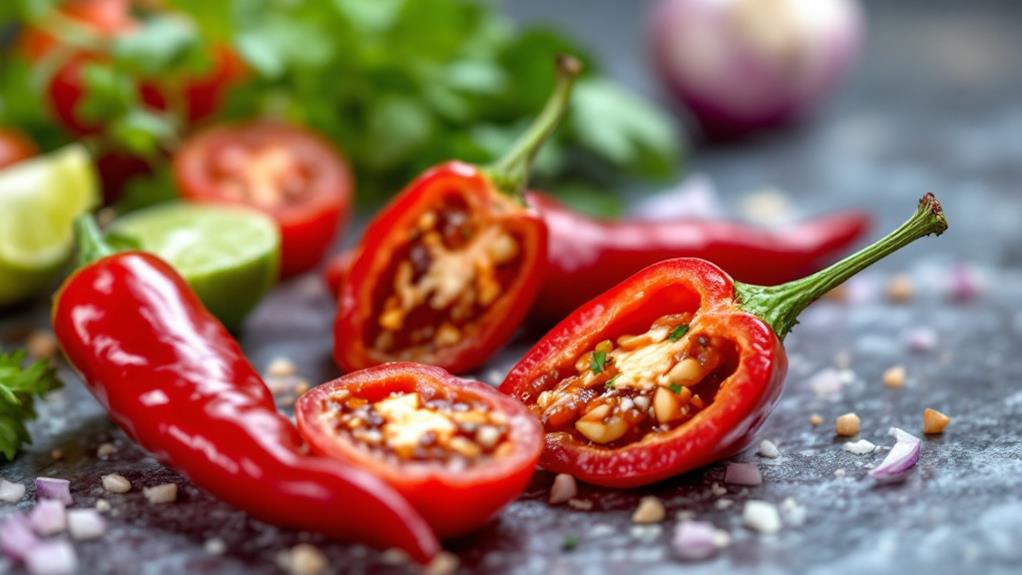What Are the Different Types of Peppers? A Guide to Heat and Flavor
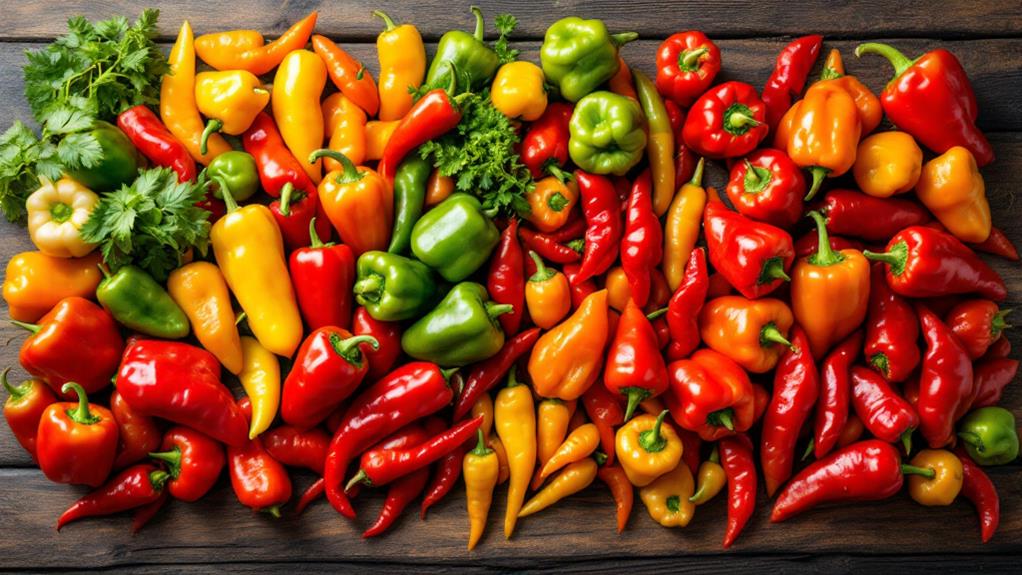
You're about to reveal the spicy world of peppers, ranging from mild to blazing hot. Bell peppers, with zero Scoville Heat Units (SHU), are sweet and perfect for snacking. If you crave mild heat, try banana or shishito peppers. Up the spice with medium heat options like poblano and serrano peppers. For those who love fiery flavors, jalapeños, habaneros, and the notorious Carolina Reaper will challenge your taste buds. Each pepper type not only excites the palate but also offers distinct flavor profiles, making them crucial for diverse culinary creations. There's a lot more exciting stuff to explore.
Understanding the Scoville Scale
When you're diving into the world of peppers, understanding the Scoville Scale is vital. This scale measures the spiciness of peppers by quantifying the concentration of capsaicin, the compound responsible for their heat. Developed by Wilbur Scoville in 1912, the scale uses Scoville Heat Units (SHU) to indicate the heat levels of different peppers. For instance, sweet bell peppers have a score of 0 SHU, while the fiery Carolina Reaper can exceed 2,200,000 SHU.
The Scoville Scale categorizes peppers into three main heat levels: mild, medium, and hot. Mild peppers, ranging from 0 to 4,000 SHU, are perfect if you prefer minimal heat. Medium peppers fall between 4,000 and 15,000 SHU, offering a noticeable but manageable spiciness. Hot peppers, with a range of 15,000 to 50,000 SHU, deliver a significant kick. It's important to keep in mind that variations in heat can occur due to factors like growing conditions and ripeness. This means that even within the same variety, you might experience different levels of heat. As you investigate different peppers, the Scoville Scale will guide you in selecting the right level of spiciness for your taste.
Mild and Sweet Peppers
Now that you understand how the Scoville Scale measures heat, let's investigate the world of mild and sweet peppers. These peppers are perfect for those who prefer flavor without the fiery kick. Bell peppers are the epitome of mild peppers, with a Scoville Heat Unit (SHU) rating of 0. They're non-spicy and ideal for a variety of culinary applications, like incorporating crunch to salads or enjoying as a snack.
Banana peppers, with their tangy sweetness, range from 0 to 500 SHU. They're a great enhancement to sandwiches and salads, offering flavor without many calories. Meanwhile, sweet Italian peppers, or pepperoncini, have a heat level of 100 to 500 SHU. Their sweet and tangy taste makes them a favorite in salads and often pickled.
Shishito peppers, typically between 50 to 200 SHU, provide a mild taste with the occasional spicy surprise. They're delightful when grilled or pan-seared. Cuban peppers, with a heat level of 1,000 SHU, offer a mild flavor suitable for salsas and sauces, showcasing their culinary versatility. These mild and sweet peppers contribute both taste and texture to your dishes.
Medium Heat Varieties
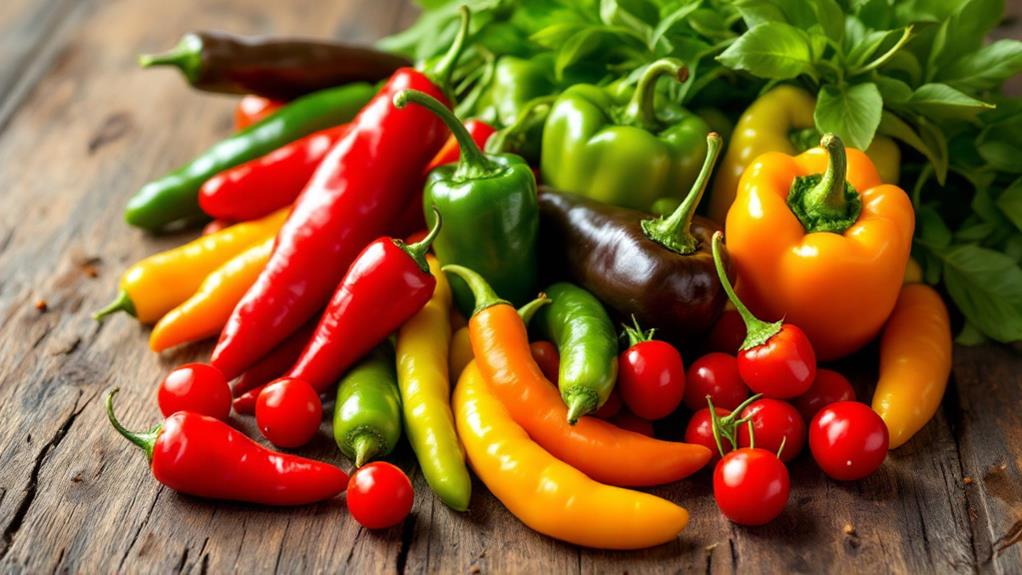
Diving into medium heat varieties, you'll find peppers that strike a perfect balance between flavor and spice, with Scoville Heat Units ranging from 1,000 to 10,000. Poblano peppers, with their rich, earthy flavor, are a staple in Mexican cuisine. They range from 1,000 to 2,000 SHU and are famously used in dishes like chiles rellenos. They're perfect if you're looking for a mild spicy kick without overwhelming your taste buds.
Anaheim peppers are another versatile choice, ranging from 500 to 2,500 SHU. These peppers are mild, often featured in Southwestern dishes, and work wonderfully in salsas and sauces. They contribute just enough heat to improve a dish without overpowering it.
Serrano peppers, hotter than jalapeños, clock in between 2,500 and 5,000 SHU. Their bright, grassy flavor makes them a great supplement to pico de gallo and salsas, offering a more intense spicy kick that still allows the flavor to shine through.
Exploring Hot Peppers
Regularly welcomed by spice enthusiasts, hot peppers offer a thrilling experience with their intense heat and diverse flavors. When you investigate these fiery delights, you'll find the Scoville Heat Unit Scale invaluable for understanding their punch. Starting with jalapeño peppers, they bring a moderate heat (2,500-8,000 SHU) and versatility, perfect for salsas and hot sauce. If you're seeking more heat, serrano peppers step it up with 10,000-25,000 SHU, adding a fresh kick to your spicy cuisines.
For those who crave even more intensity, Habanero peppers deliver both heat and a fruity flavor, boasting 100,000 to 350,000 SHU. These are favorites in Caribbean dishes, where their unique taste amplifies spicy recipes. When you're ready to face the extreme, Ghost Peppers, or Bhut Jolokia, await you. With a scorching 800,000 to over 1,000,000 SHU, they require caution but reward with unmatched intensity in hot sauces and spicy dishes.
Don't overlook cayenne pepper, usually found in powdered form. It offers a robust heat of 30,000-50,000 SHU, ideal for seasoning and elevating your culinary creations. Welcome the fiery world of hot peppers and transform your meals.
The Hottest Pepper Types
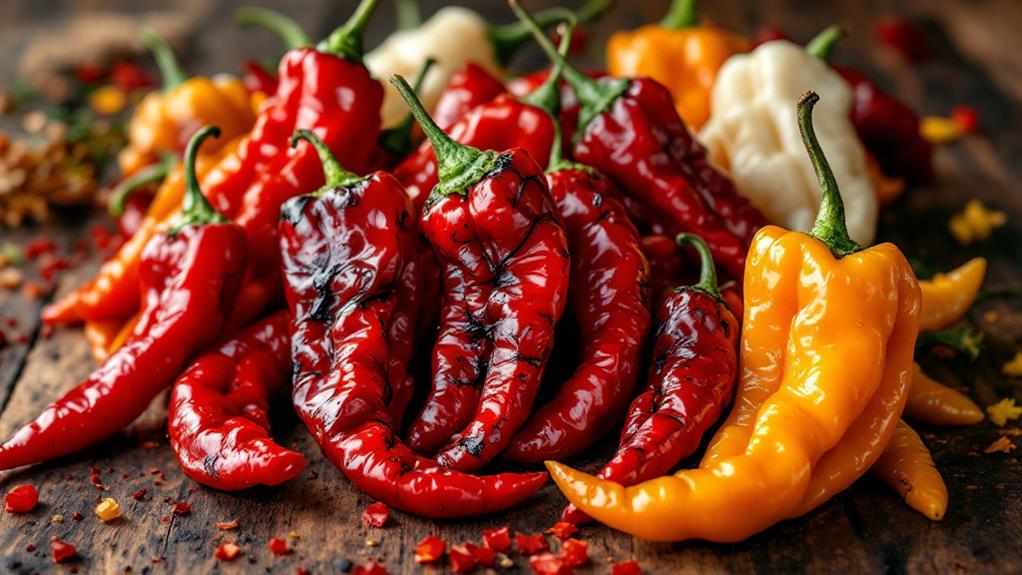
With regard to the hottest pepper types, the Carolina Reaper reigns supreme. Known as the world's hottest pepper, it boasts an astonishing Scoville scale rating between 1,400,000 and 2,200,000 SHU. Despite its intense heat level, the Carolina Reaper surprises many with its sweet and fruity flavor, making it a unique spicy chili experience.
Next on the list is the Ghost Pepper, or Bhut Jolokia, with a heat level ranging from 800,000 to 1,000,000 SHU. This pepper offers a slightly sweet and nutty taste, providing a different yet intense heat experience.
Habanero peppers are another staple in the world of extremely spicy chilis, with their Scoville scale ratings between 100,000 and 350,000 SHU. They're cherished for their fruity and floral flavors, primarily in Caribbean cuisine.
Scotch Bonnet peppers share a similar heat level to habaneros, also ranging from 100,000 to 350,000 SHU. These peppers are crucial in Jamaican dishes, offering a delightful sweet and spicy flavor.
Culinary Uses of Peppers
While the hottest peppers bring an intense kick, their uses in the kitchen are surprisingly varied and flavorful. From sweet bell peppers to fiery hot varieties, each pepper offers unique culinary applications. Sweet bell peppers, with their mild flavor, are perfect for salads, stir-fries, or simply as crunchy snacks. On the other hand, hot peppers like jalapeños and habaneros can uplift your salsas, sauces, and spicy dishes with their distinct heat, measured in Scoville Heat Units (SHU).
Mild peppers, such as Anaheim, are ideal for family-friendly meals, offering just enough heat without overwhelming the palate. For those seeking adventure, ghost peppers, with their soaring SHU, should be used sparingly to incorporate intense flavor. Stuffed peppers, like poblanos or cubanelles, showcase the versatility of pepper varieties, allowing for a range of fillings, including meats, grains, and cheeses.
Roasting and grilling peppers can improve their natural flavors, making them a delightful supplement to sauces and marinades. In Mexican cuisine, serrano peppers are crucial for crafting authentic pico de gallo. Meanwhile, Scotch bonnets are indispensable in Caribbean jerk recipes. Accept the diversity of peppers in your culinary adventures!
Nutritional Benefits
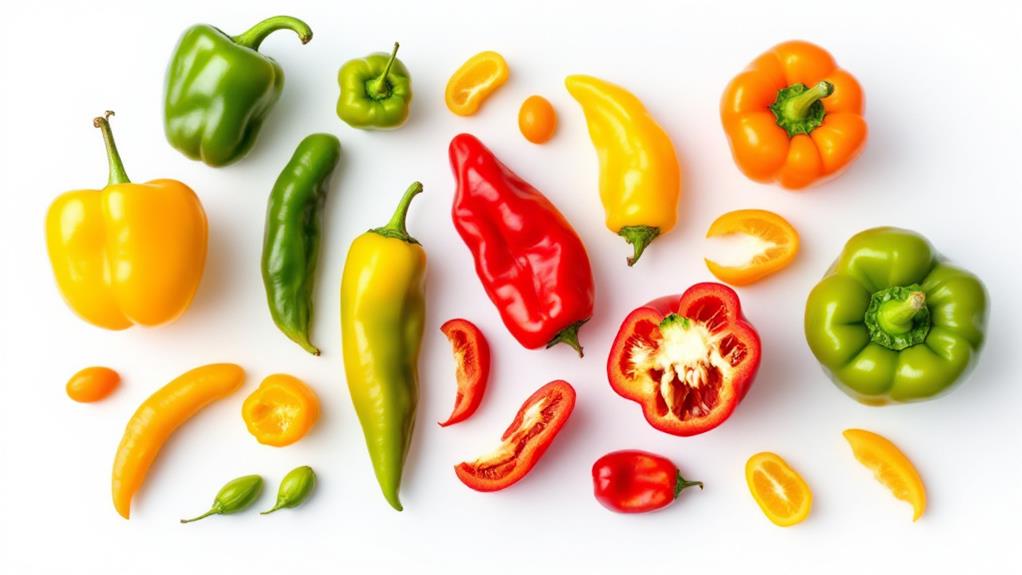
Peppers often pack a powerful punch of nutrients, making them an excellent supplement to any diet. Peppers are rich in vitamins A and C, which contribute considerably to immune function and skin health. For example, bell peppers can provide over 150% of your daily vitamin C needs in just one serving. Plus, many varieties, including banana and bell peppers, are low in calories, allowing you to enjoy them freely without worrying about adding extra pounds.
The presence of capsaicin in hot peppers offers more than just fiery flavor—it also has anti-inflammatory properties and can aid in weight management. Capsaicin might help enhance metabolism and curb your appetite, making it easier to maintain or achieve a healthy weight. Peppers are also packed with antioxidants, which help combat oxidative stress, potentially reducing the risk of chronic diseases like heart disease and cancer.
Further enhancing their nutritional profile, peppers boast a high fiber content. This fiber promotes digestive health by supporting regular bowel movements and contributing to a feeling of fullness, aiding in weight control. By incorporating peppers into your meals, you can enjoy their health benefits while enhancing flavor and nutrition.
Growing and Heat Variation
Although often overlooked, the growing conditions of peppers play a crucial role in determining their heat levels and flavor profiles. Climate, soil type, and water availability influence the capsaicin concentration, which directly impacts how spicy a pepper can be. Environmental stressors, such as drought or excessive heat, can elevate the spiciness, while ideal conditions might result in milder flavors. Even within the same pepper variety, like jalapeños, distinct flavor profiles emerge depending on where they're grown—Mexican jalapeños may taste different than those from the United States.
The stage of ripeness also greatly affects heat and flavor. Fully ripe peppers tend to carry more intense flavors and higher heat levels as they've had more time to develop capsaicin. Furthermore, variations in heat can occur within a single pepper variety. Take the Shishito pepper, for example: about 1 in 10 can surprise you with unexpected heat, despite being from the same plant.
Understanding these factors helps you appreciate the complexity behind each pepper's flavor and heat. Regardless of whether you prefer blazing heat or a milder experience, knowing how growing conditions shape your peppers can enrich your culinary adventures.
Selecting and Storing Peppers
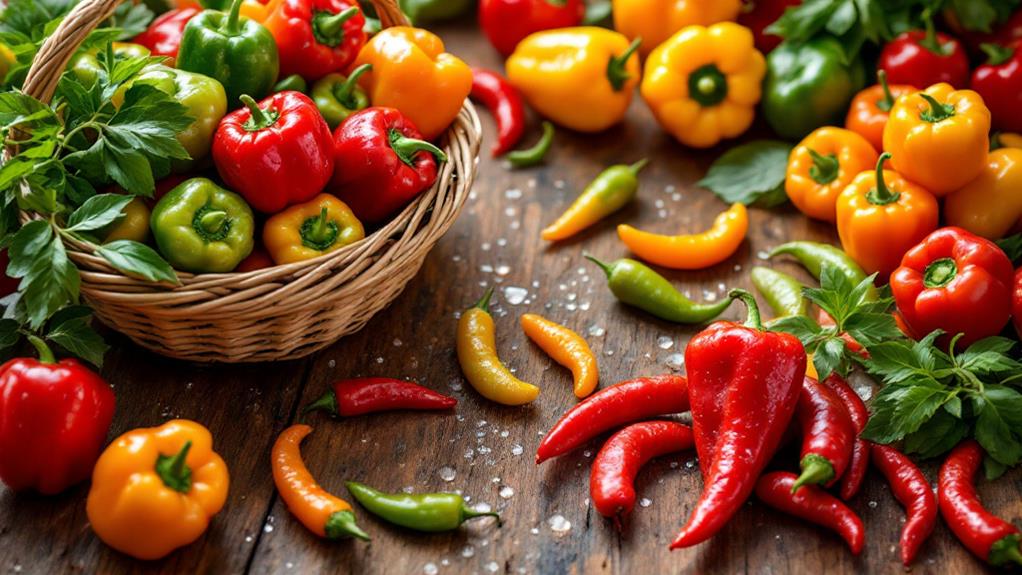
Choosing the right peppers guarantees you get the best flavor and heat for your culinary needs. When selecting peppers, focus on those that are firm and boast lively colors. Avoid any with signs of spoilage or wrinkling to guarantee freshness and quality. Remember, the heat levels of peppers can vary with growing conditions and ripeness, so it's wise to do some taste-testing, especially with new varieties.
After making your selection, proper storing is key to maintaining their quality. Keep fresh peppers in the refrigerator's vegetable drawer, as this environment helps them last up to one week. Don't wash them until you're ready to use them to prevent moisture buildup, which can lead to spoilage.
For long-term storage, drying or freezing is effective. Dried peppers can be ground into powder or used whole, while frozen ones retain both flavor and nutrients. Always handle hot peppers with care by wearing gloves to avoid skin irritation from capsaicin. Afterward, wash your hands thoroughly to prevent accidental transfer of heat.

